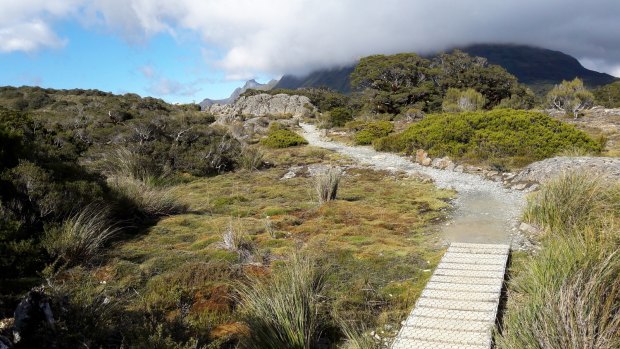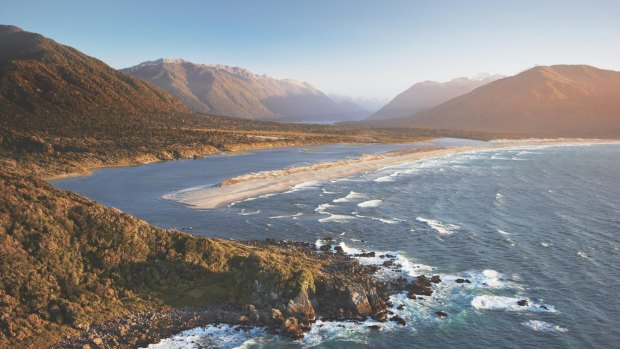By Andrew Bain

This is a hike in the mountains that doesn't climb mountains.
In a swathe of rainforest near the mouth of New Zealand's Hollyford River, the food chain is alive and well. Tiny fantails flicker about eating sandflies, and sandflies flicker about eating us. High above, bellbirds chime from the treetops.
"There are times I'm here that I have to shout to make myself heard over the bellbirds," says hiking guide Seb Thomas. It's the finest form of traffic noise.
We're hiking the Hollyford Track, a 56-kilometre trail through the longest valley in Fiordland National Park. While overshadowed by Fiordland's signature Milford Track, the Hollyford is a popular hike that yields far more easily.

An aerial view of Long Reef and Martins Bay.
Though it skims the toes of one of New Zealand's most dramatic mountain ranges as it heads to the Tasman Sea at Martins Bay, it never rises out of the valley.
It's a hike in the mountains that doesn't climb mountains, and I've come on a trip that makes an easy track even easier. My hike will consist of a helicopter flight and a couple of jet-boat rides, with a bit of walking thrown in.
The journey begins one valley to the south, in the deep trough of Milford Sound, where we board a helicopter to fly to Martins Bay. As we rise into the sky, waterfalls pour down below us, running slick over granite walls that plunge sheer into New Zealand's most famous body of water. Tourist boats float about the sound like bath toys.
To reach Martins Bay from Milford Sound might normally take five days, driving to the road end in the Hollyford Valley and then hiking the length of the Hollyford Track. Within 15 minutes, however, we've flown over the Darran Mountains, regarded by mountaineers as New Zealand's most difficult peaks, and landed in a clearing beside a lunch tent a few kilometres from the mouth of the Hollyford River.
The lodge that will be our home this night is just a few hundred metres away, on the site of the original homestead of Davey Gunn, the legendary farmer who worked the Hollyford Valley for almost 30 years from 1926. Hikers have been heading through the valley since Gunn himself began guiding trips in the 1930s.
After lunch we set out hiking towards the coast, wandering through classic west-coast rainforest where every tree and rock is cushioned in moss. It's evidence that we're walking in one of the wettest places on earth, with average rainfall around Fiordland topping six metres a year. Unusually, it's simply overcast this day.
It's a landscape that changes in an instant as we approach Jerusalem Creek, where a few years ago heavy sediment began pouring down the stream. The water can no longer be seen or found. Instead, the sediment has engulfed parts of the forest, leaving an incongruous bare scar.
"It's like walking out onto the surface of the moon," says Seb.
The mouth of the Hollyford River is a curious place. On one side, it wraps around a three-kilometre-long sand spit that once appeared on the cover of National Geographic. On the other, where we walk, the riverbank is a jumble of boulders deposited by the glacier that created the valley, which was once the northernmost of New Zealand's fiords.
At one point I stop to take a photo of the boulders, and one of them moves – it's actually a fur seal, now scuttling back to the sea. Long Reef is clearly nearing.
Though the Hollyford Track ends at the river mouth, we keep walking, reaching the finger of land that is Long Reef. If I could see far enough across the ocean from here, the view would pass below Tasmania and Africa to South America.
Long Reef's other geographic reference point is that it's Fiordland National Park's northernmost point, but it's most famous as a seal colony. Its boulders serve as hard sofas for one of New Zealand's largest fur-seal populations, and yet strangely there are only a few seals here this day.
Instead, sandflies whirl about like storm clouds, and the view encompasses the unusual combination of wild seas, a sand spit and snow-capped mountains rising almost 3000 metres above the coast.
From Long Reef, we retreat towards the lodge, but we don't have to walk far. Along the riverbank we're met by the Hollyford Track's private jet-boat, which takes us first across the river for a stroll on the sand spit and then whisks us upstream to the lodge. What we've walked in three hours passes in minutes.
The private Martins Bay lodge sits among lawns on the northern bank of the river. Its main building features a large and plush lounge and dining room, with a sheltered walkway behind that leads to eight bedrooms, each with a set of bunks and heated towel racks. Abalone shells and river pebbles decorate the rooms.
Two lodge hosts prepare the meals, and the evening begins with a platter of South Island cheeses, beers from Queenstown's Altitude Brewing and a fine selection of New Zealand wines. Dinner is the baked blue cod that graces so many good menus across New Zealand's far south.
The next morning starts with a 40-minute jet-boat ride, traversing long Lake McKerrow and wriggling upstream on the Hollyford River to its junction with the Pyke River. As we sit cocooned in the dawn on the fast-moving boat, we're cutting out the most difficult section of the Hollyford Track – the rocky, rooty and muddy Demon Trail.
The valley has been washed clean by overnight rain, and Lake McKerrow is so flat and reflective it's as though we're skating across it. Mist is strung across the lake like a tendon, and by the time we reach the head of the lake, we're engulfed in cloud. The sky is grey, the lake is grey, and ferns and forest form ghostly figures through the mist. The whole scene feels primeval - a journey into prehistory on a jet-boat.
From the Pyke River, it's an 18-kilometre walk to the road end, where most hikers start rather than finish the track, heading through rainforest so thick that even the light somehow seems green.
When the forest does break open occasionally, it reveals views of the Darran Mountains, which were a proving ground for New Zealand's first Everest climbers. Ed Cotter, who was part of the country's first Himalayan expedition with Sir Edmund Hillary in 1951, was even a guide on the Hollyford Track.
"I think the success of the Everest expedition was down to those climbs in the Darrans," Seb says. "They came in here as explorers and left as climbers."
Typical of Fiordland, waterfalls pour down around us as we head towards the trail's end, their echoes following us long down the valley. When we stop, robins hop about our feet, hoping to snack on bugs from the ground disturbed by our boots, and bellbirds continue their concerts from the trees.
The Hollyford River runs as clear as air beside us, and sunlight begins to pour through gaps in the forest. The way has been easy and the days have been dry. It's been an uncommon experience in Fiordland.
TRIP NOTES
MORE
FLY
Air New Zealand flies direct to Queenstown from Melbourne up to eight times per week, and from Sydney up to nine times per week. See airnewzealand.com.au
HIKE
World Expeditions runs a seven-day Fiordland, Hollyford and Stewart Island Trails trip that includes a two-day guided walk on the Hollyford Track, staying at the private Martins Bay hut. Prices start at $3450. See worldexpeditions.com
FIVE NEW ZEALAND VALLEY WALKS
GREENSTONE CAPLES TRACK
From the shores of Lake Wakatipu, head up the Caples Valley to almost reach the Routeburn Track, swinging back to the lake through the Greenstone Valley.
REES-DART TRACK
Another horseshoe trail through a pair of valleys – the Rees and the Dart – cutting beneath the nose of the Dart Glacier.
HOOKER VALLEY
A short walk that's long on reward, heading through the flat Hooker Valley to a glacier and an iceberg-filled lake at the foot of the country's highest mountain.
PUTANGIRUA PINNACLES
A short riverside stroll into a badlands landscape of eroded hoodoos and cliffs that appeared as Dimholt Road in Lord of the Rings.
TRAVERS-SABINE CIRCUIT
Head deep into the Southern Alps, hiking up the Travers Valley from the Nelson Lakes before crossing Travers Saddle to return along the Sabine Valley.
Andrew Bain travelled courtesy of World Expeditions, Tourism New Zealand and Air New Zealand.
Sign up for the Traveller Deals newsletter
Get exclusive travel deals delivered straight to your inbox. Sign up now.